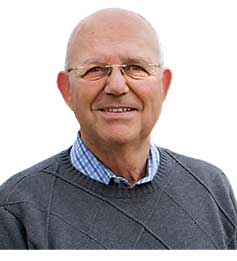Making a Wisconsin connection

Mike Kenna
I started thinking about an interesting connection between the past and present while reviewing the Microdochium patch article in this issue by the University of Wisconsin turfgrass pathologist, Paul Koch, Ph.D. For some reason, it reminded me of the USGA Green Section history about John Monteith Jr., Ph.D.
Born on Dec. 25, 1893, in Chatham, N.J., Monteith graduated in 1917 with B.S. and M.S. degrees from Rutgers University. He served in the Army at the end of World War I from 1917 to 1919. After his service, he went to the University of Wisconsin and received his Ph.D. in 1923. I would consider Monteith the first turfgrass pathologist in the United States. The U.S. Department of Agriculture employed him to work on turfgrass in 1924. Two years later, he named dollar spot, which was called small brown patch up to that time. Monteith wrote at length, providing experimental evidence that damaged turf often was due to fungal disease rather than insects or drought.
In the May 1928 issue of The National Greenkeeper (now Golf Course Management), he wrote, “Frequently, we hear greenkeepers and members of green committees speak of grass diseases as something amazingly new. They regard them as pests recently invented with the sole purpose of adding to the worries of those men who struggle to keep the turf in perfect playing condition throughout the season.”
In 1928, Monteith was asked to lead the USGA Green Section, and he served as the Green Section Director until 1942. He left to join the War Department during World War II, which developed a Turf Unit to construct tough, wear-resistant grasses for Army airfields. Before leaving, he developed the first effective chemical control for brown patch, dollar spot and snow mold, and he co-authored the classic Turf Diseases and Their Control with Arnold Dahl, Ph.D.
Why the connection between Monteith and Koch? In part, it is the University of Wisconsin, but more interesting is the leadership Koch has provided on dollar spot. In spring 2017, the USGA Turfgrass and Environmental Research Program invited several turfgrass pathologists to discuss dollar spot, new disease-resistant bentgrasses, forecast models, resistant strains of dollar spot and alternative management practices.
Koch then organized more than 20 turfgrass pathologists to attend a follow-up meeting at the 2018 Golf Industry Show and worked with attendees to develop a federal grant to continue the discussion.
In April of 2019, Koch and his colleagues received a grant from the National Institute for Food and Agriculture. The project title is “Biology, Etiology and Management of Dollar Spot in Turfgrass.” The first step is to review past and current dollar spot work, identify critical knowledge gaps and plan future projects collaboratively and strategically over the next five years. The first meeting was scheduled for late March 2020, but COVID-19 caused the cancellation of the event. The meeting was open to industry partners, golf course superintendents and other turf professionals. Overall objectives include:
- Improve our understanding of dollar spot biology and epidemiology through taxonomic analysis, molecular assay development and host-pathogen interaction research.
- Assess current dollar spot resistance among bentgrass cultivars and new selections, identify barriers to their utilization in golf course establishment and renovations and develop strategies for overcoming the identified obstacles.
- Develop cultural-based dollar spot management strategies that combine various cultural practices (e.g., fertility, rolling, topdressing, irrigation) to limit dollar spot development in multiple geographic regions.
- Develop integrated and targeted chemical dollar spot management strategies that maintain current levels of disease control, potentially reduce chemical inputs and limit the development of fungicide resistant populations.
- Assess the ability of antagonistic organisms to suppress dollar spot when combined with those above cultural and chemical strategies.
Nearly 100 years after Monteith named dollar spot, Koch and his colleagues are still finding ways to manage the disease efficiently. Let’s hope they can meet soon and get the collaborative research rolling!










